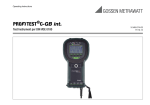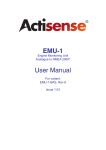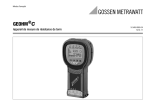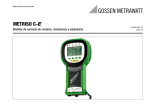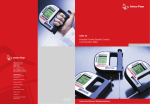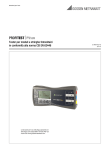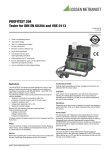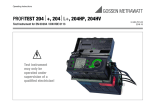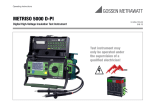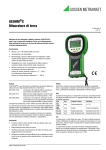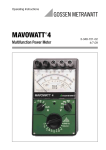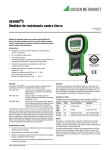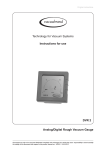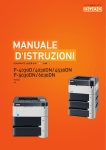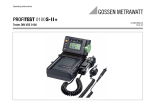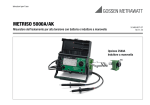Download METRISO C-GB int. - GMC
Transcript
Operating Instructions METRISO C-GB int. Insulation, Resistance and Contact Current Measuring Instrument 3-349-087-03 18/7.14 METRISO C Measuring and Test Instrument Infrared interface METRISO C Control Panel and Display Temperature and humidity measuring adapter Z541A Operating and display unit t npu nt i e m ure eas 5V >2 en t e u np etw nput i nt i tm Vb me ea 50 ment e g r 1 a u re olt eas ev nce asu at m enc ere nd me tion r f f a e e i l f d io ag ter ial tact a ev volt r in ent valu ion so t t Pot er con i n a i l u Lim Ma Ins fing Indicator lamps Netz Mains LCD LIMIT U>25V Battery level display The scroll bar indicates which menu is currently open. Contact surface 2 Fuse Shield jack Meas. jack + pole Car ryin gs trap e sur Clo Measurement jack, COM Socket for external charger article no. Z501N The desired measuring functions can be displayed with the help of the and keys. Keys for the selection of basic functions and sub-functions, (menu-driven operation) START Toggle Switch Middle switch contact: Starts measurement Left switch contact: Displays basic functions, scrolling from right to left Right switch contact: Displays basic functions, scrolling from left to right GMC-I Messtechnik GmbH + LCD after Switching on the Instrument Please proceed as follows if the LCD display is not legible, i.e. too bright or too dark, after switching on the test instrument: 1 Simultaneously press the two right-hand keys to delete the memory which might be faulty. 2 Wait a few seconds to allow the display to be updated. 3 Readjust the contrast if necessary, see page 8. Instructions for the Plug-on of the Following Accessory Adapters • Interface converter IrDa-USB (Z501J) • Temperature and humidity measuring adapter (Z541A) Ð Connect the adapter with the IR interface of the test instrument, see drawing on page 2: Insert the guide rail of the adapter in the opening provided on top of the tester so that the adapter is located in the middle of the housing, resting on the two rubber cushions. Then push the adapter down to ensure that it is safely fastened. GMC-I Messtechnik GmbH PC software WinProfi for communication with METRISO C The free PC starter software WinProfi (can be used currently up to Windows 7 (32 bit)) is used for communication with your METRISO C test instrument. WinProfi is available on our homepage with the following content and functions: • up-to-date test instrument software – for loading another language – for loading software version updates, • Exchange of measured data between test instrument and PC The following interface adapter is required for communication between test instrument and PC: – IrDa-USB Converter (Z501J): IrDa (tester) – USB (PC) Up-to-date PC software (free of charge starter or demo software for data management, report and list generation) is available from our homepage for download. Data Backup Measurement data and electrical circuit assignments can be safely stored in a RAM as long as the associated battery supplies the required voltage. We advise you to regularly transmit your stored data to a PC in order to prevent potential loss of data in the test instrument. We assume no responsibility for any data loss. For data processing and management we recommend the following PC software programs: • PS3 (transmission of measurement data to the PC, documentation, management, report generation and monitoring of deadlines) • PC.doc-WORD™/EXCEL™ (report and list generation) • PC.doc-ACCESS™ (test data management) 3 Contents Page Contents Page 1 Applications .....................................................................................4 10 2 Safety Features and Precautions ....................................................5 10.1 Setting the Limit Value ................................................................ 22 Measuring Contact Current ...........................................................22 11 Characteristic Values ....................................................................23 12 List of Abbreviations and their Meanings .....................................25 13 Maintenance .................................................................................25 3 Initial Start-Up .................................................................................6 3.1 3.2 3.3 3.4 3.5 Battery Test ..................................................................................6 Installing and Replacing Batteries ..................................................6 User Guide in a Different Language ...............................................6 Selecting a Menu and Configuring Basic Settings .....................6 Downloading a Software Update, Managing Report Data .............9 4 General Operation .........................................................................12 4.1 4.2 4.3 Automatic Settings, Monitoring and Shutdown ...........................12 Measurement Value Display ........................................................12 Online Help .................................................................................12 13.1 Self-Test ................................................................................ 25 13.2 Battery Operation ....................................................................... 26 13.3 Changing the Batteries of the Temperature and Humidity Measuring Adapter Z541A ........................................................ 26 13.4 Fuses ......................................................................................... 26 13.5 Housing ..................................................................................... 27 13.6 Recalibration .............................................................................. 27 5 Measuring Insulation Resistance ..................................................13 14 5.1 5.2 5.3 Insulation Measurement with Adjustable Test Voltage .................14 Measurement with Rising Test Current ........................................14 Setting the Limit Value ................................................................14 Repair and Replacement Parts Service Calibration Center and Rental Instruments Service ......................28 15 Product Support ............................................................................28 1 Applications 6 Database Functions .......................................................................15 6.1 6.2 6.3 6.3.1 6.3.2 6.3.3 6.4 Creating a Data Record – Data Function .....................................15 Saving Measurement Values – STORE Function .........................16 Querying Data Records – View Function .....................................16 Deleting a Data Record from within a Memory Address – View Function ...........17 Deleting a Memory Address – Data Function ..................................................17 Delete All Memory Addresses – Data Function ................................................18 Print Function .............................................................................18 7 Measuring Alternating Voltage ......................................................19 8 Measuring Temperature and Humidity with Adapter Z541A (Accessory Adapter) ......................................................................19 9 Measuring Low-Value Resistance (to 100 ) ...............................20 9.1 9.2 Compensation for Measurement and Extension Cables (up to 10 ) .....21 Setting the Limit Value ................................................................21 4 This instrument fulfills the requirements of the applicable European and national EC guidelines. We confirm this with the CE marking. The relevant declaration of conformity can be obtained from GMC-I Messtechnik GmbH. The METRISO C test instrument allows for quick and efficient testing of protective measures in accordance with DIN VDE 0100, ÖVE-EN 1 (Austria), NIN SEV 1000:2010 (Switzerland) and other country specific regulations. The instrument is equipped with a microprocessor and complies with IEC/EN 61557/VDE 0413. Part 1: General requirements Part 2: Insulation resistance measuring instruments Part 4: Measuring instruments for the measurement of resistance at earth conductors, protective conductors and bonding conductors Part 10: Combined measuring instruments for the testing, measuring or monitoring of safety measures GMC-I Messtechnik GmbH as well as requirements in accordance with VDE 0701-0702: Repair, modification and testing of electrical devices The test instrument is especially well suited for: • Systems installation • Initial start-up • Periodic testing • Troubleshooting in electrical systems All required measurements can be performed for approval reports (e.g. for ZVEH) with the help of a set consisting of the PROFiTEST C and the METRISO C. Measurement values can be transmitted to a PC for printing and archiving via the integrated IR data interface at the METRISO C. This is especially important where product liability is concerned. The following measurements and tests can be performed with the METRISO C: • Insulation resistance • Low-value resistance • Contact current • Voltage and frequency • Temperature and humidity (with accessories) The following can also be measured with a shielded measurement cable: • Conductivity of floor coverings for electrostatic discharge 2 Safety Features and Precautions The electronic test and measuring instrument METRISO C has been built and tested in accordance with the following standards: IEC 61010-1:2010, EN 61010-1:2010, VDE 0411-1:2011 IEC 61557-1, -2, -4, -10 DIN EN 61557-1:2007, -2:2007, -4:2007, -10:2001 VDE 413-1:2007, -2:2008, -4:2007, -10:2001 The safety of the user and the instrument is guaranteed provided that the instrument is used for its intended purpose. GMC-I Messtechnik GmbH Read the operating instructions carefully and thoroughly before using your instrument, and observe all instructions included therein. The measuring and test instrument may not be used: • If the battery compartment cover has been removed • If external damage is apparent • With damaged connector cables or measuring adapters • If it no longer functions flawlessly • After excessive stress due to transport • While the batteries are being charged Meanings of Symbols on the Instrument Warning concerning a point of danger ! (Attention: observe documentation!) Protection class II device CAT II Measuring category I I device – 9 V DC charging socket for NA102 charging adapter (part no. Z501N) Indicates EC conformity This device and the inserted (rechargeable) batteries may not be disposed of with the trash. Further information regarding the WEEE mark can be accessed on the Internet at www.gossenmetrawatt.com under the search term ’WEEE’. Opening of Equipment / Repair The equipment may be opened only by authorized service personnel to ensure the safe and correct operation of the equipment and to keep the warranty valid. Even original spare parts may be installed only by authorized service personnel. In case the equipment was opened by unauthorized personnel, no warranty regarding personal safety, measurement accuracy, conformity with applicable safety measures or any consequential damage is granted by the manufacturer. 5 3 Initial Start-Up 3.1 Battery Test Five battery symbol segments ranging from depleted to fully charged continuously indicate the current battery level at the main menu. 3.2 Installing and Replacing Batteries New batteries must be installed before initial start-up, or when only one solid segment remains in the battery symbol. ! 3.4 Selecting a Menu and Configuring Basic Settings Attention! The instrument must be disconnected from the measuring circuit (mains) at all poles before the battery compartment is opened. Four 1.5 V baby cells in accordance with IEC LR14 are required for operation of the METRISO C. Use alkaline-manganese batteries only. Rechargeable NiCd or NiMH batteries can be used as well. Be absolutely sure to refer to chapter 13.2, page 26, regarding the charging cycle and the charging adapter. Always replace the batteries in complete sets. Dispose of batteries in an environmentally sound fashion. Ð Loosen the two slotted screws at the battery compartment cover on the housing rear panel and remove the cover. Ð Insert four 1.5 V baby cells making certain they are poled in accordance with the symbols. Insert the two batteries which are half covered by the housing first. Ð Replace the cover and retighten the screws. ! 3.3 User Guide in a Different Language By performing a software update it is possible to load another language for the user guide than the one included in the scope of supplies. Any language currently available is proposed for choice when WinProfi is being installed, see chapter 3.5. Attention! The instrument may not be operated if the battery compartment cover has not been installed and properly tightened! START START Press the or the key in order to display the desired measuring function, the device settings or the database functions. 6 GMC-I Messtechnik GmbH Default Settings – Last Used Settings A selection can be made here as to whether the menus will be displayed according to the default settings, or if the last opened menus should be displayed. Setting On-Time, Manual Shutdown Ð Ð Ð Activate the Setup key. Ð Press the Default key, if required: on 3 Settings such as Ton (= 20sec) are reset to the default settings each time the instrument is switched on. off 3 The last used settings remain when the instrument is switched on. Ð Press the key to quit the setup menue. GMC-I Messtechnik GmbH Ð Activate the Setup key. Press the Ton key and then the 10sec, 20sec, 30sec or 60sec key depending upon the desired duration after which the test instrument should switch off automatically. Additional setting options can be displayed with the help of the and scroll keys. The “>>>>>” setting indicates that no automatic shutdown will occur. The selected setting has a considerable influence on battery service life. Press the key to quit the setup menue. The instrument can be switched off manually by simultaneously activating the two outermost softkeys. 7 Setting the Clock Background Illumination and Contrast LCD Illumination off on Ð Ð low Contrast high Activate the Display key. In order to extend battery service life, display illumination can be switched off entirely. Press the corresponding softkey to this end. If LCD illumination is activated (= ON), it is automatically switched off several seconds after the last key has been activated in order to extend battery service life. As soon as a key is activated again, illumination is switched back on. Ð Contrast can be optimized with the two keys at the far right. Ð Press the START key to quit the setup menue. The data are saved to memory. 8 Ð Ð Ð Ð Activate the Time key. The cursor appears at the first digit in the date. Enter the desired numeral with one of the softkeys. Numerals which do not appear in the window can be displayed with the help of the or the key. Each time a numeral is selected, the cursor moves to the next position to the right. Date and time are saved as soon as the last numeral has been entered. Press the START key to quit the setup menue. The data are saved to memory. GMC-I Messtechnik GmbH 3.5 Downloading a Software Update, Managing Report Data If you require an updated test instrument software, it can be downloaded with the help of WinProfi* PC software. The data file with the desired software version is transmitted to the test instrument via the serial interface. The previously installed language is overwritten. + Note This software includes all of the functions required for communications between the METRISO C and the PC. A description of the program is included in the online user’s manual which can be accessed from WinProfi. A Install WinProfi to the PC and Start the Program Ð Download the WinProfi software from our homepage: http://www.gossenmetrawatt.com ( Products Software Software for Testers WinProfi) Ð Unzip the zip file „winprofi.zip“. Ð Install the software on your PC by executing file Setup_WinProfi_Vx.xx.exe. Ð Select the desired language for the WinProfi software and for the user interface of the test instrument. Ð Follow the instructions which appear at the monitor. The program is added to your START menu after installation in directory ... /WinProfi.. Ð Ð Ð Ð Establish a connection between your PC and the METRISO C test instrument by using interface converter IrDa-USB. Start WinProfi. Switch on the test instrument. Set the on-time period of the METRISO C to „>>>>>“, to give you enough time for adjusting the settings in WinProfi before the test instrument switches off again automatically, see chapter 3.3. Display or print out online user’s manual The online manual contains information concerning the software which is not included in these operating instructions. Programm WinProfi * WinProfi can be used currently up to Windows 7 (32 bit) GMC-I Messtechnik GmbH 9 B Prerequisites for Software Update or Data Exchange Ð Find the interface to which the METRISO C is connected. C Transmission of a Software Update to the Test Instrument Ð + Ð PC: Select the Update All function from the Update menu. Follow the instructions which appear at the monitor. Depending upon the utilized PC, transmission takes from 1 to 2 minutes. Note Always start this function first, before performing an update or changing report templates. After starting this function, WinProfi loads the report files specifically necessary for the connected instrument. Due to the fact that WinProfi has been created for use with several types of test instruments, incorrect test reports may otherwise be loaded, or erroneous options may be made available. The NETZ/MAINS LED of the METRISO C test instrument lights up green and indicates that the instrument is ready to receive data. If the PC and the test instrument are correctly synchronized, the same LED lights up yellow. During programming sequences, the LIMIT and U>25V LEDs light up red and the NETZ/MAINS LED lights up yellow in alternating order. Upon completion of data transmission, the NETZ/MAINS LED briefly lights up green, afterwards all LEDs go out. The message „Transmission done“ appears on the computer screen Query information regarding current software version ! 10 Attention! The instrument may not, under any circumstances, be switched off during transmission, nor may the connection between the instrument and the PC be interrupted! GMC-I Messtechnik GmbH D Managing Report Data Ð Connect the METRISO C test instrument with your PC via the IrDaUSB converter Ð Start WinProfi. Ð Switch on the test instrument. Ð Set the on-time period of the METRISO C to „>>>>>“, to give you enough time for adjusting the settings in WinProfi before the test instrument switches off again automatically, see chapter 3.3. • Send or receive a data file • • Edit or transmit report templates Print data 1 2 3 6 5 4 GMC-I Messtechnik GmbH 11 4 General Operation The test cables are connected to the “+” and “COM” jacks. The shielded cable should also be connected to the COM and SHIELD jacks for the measurement of electrostatic discharge capacity at floor coverings. (Accessory equipment KS-C „Cable set consisting of measurement cable and high-resistance measurement cable for METRISO C, for measurements in the G range“, see connection diagram). Observe color codes when connecting the cables! + COM SHIELD KS-C (Z541F) 4.1 Automatic Settings, Monitoring and Shutdown The instrument cannot be placed into operation, or it is shut down automatically, if battery voltage has fallen to below the lower limit value. Measurement is automatically interrupted and/or the measuring function is disabled if voltage exceeds the allowable limit in the resistance range (U > 25 V). The instrument switches itself off automatically, at the earliest after the current (automatic) measuring sequence has been completed, and after the predefined on-time has elapsed (see chapter 3.4). On-time is reset to the duration selected in the setup menu each time a key is activated. 4.2 Measurement Value Display The following is displayed at the LCD: • Measurement values with abbreviated quantity type and units of measure • The selected function When automatic measuring sequences are used, the measurement values are displayed in digital format until the next measuring sequence is started, or until the instrument switches itself off automatically. If the measuring range upper value is exceeded, the upper value is displayed preceded by the greater than symbol “>” in order to indicate over-ranging. 4.3 Online Help Appropriate online help texts can be displayed at the LCD for each of the basic functions and sub-functions, after the respective function has been selected in the corresponding menu. Ð Press the i key to query online help. Press any key to exit the help function. Lamp Functions Lamp Status red Function Potential difference 150 V between finger contact and measurement input Line voltage or interference voltage is present at the measurement inputs Netz blinking red (insulation resistance and low resistance measurement are disabled) Mains LIMIT red – Measured insulation resistance is less than the selected limit value. – The measured low-value resistance is less than the allowable limit value. U>25V red A voltage of greater than 25 V is present at the measurement inputs. The discharging process is not yet complete. 12 GMC-I Messtechnik GmbH 5 Measuring Insulation Resistance Insulation resistance can only be measured at voltage-free objects. If mains voltage or an interference voltage is applied to the measurement cables, insulation resistance is not measured and the Netz/Mains lamp lights up. + Note Testing of Measurement Cables We recommend short-circuiting the measurement cables with the test probes before carrying out the insulation measurement to check whether the instrument indicates almost zero W (see chapter 9). This helps to discover interruptions in the measurement cables which simulates a high insulation resistance. ! + Attention! Do not touch the connector terminals at the instrument during performance of insulation resistance measurement! Note Three-Phase Current Systems All conductors (L1, L2, L3 and N) must be measured against PE! If the connector terminals are free, or if they have been connected to an ohmic power consumer for the performance of a measurement, a current with a value of approximately 1 mA would flow over your body at a voltage of 1000 V. This electrical shock is not life endangering. However, the plainly perceptible shock may result in injury (as a result of startling etc.). Capacitive Devices Under Test ! Ð Press the RISO key. The currently selected test voltage (nominal voltage) is displayed between RISO and UISO. Ð Select another test voltage if necessary by pressing UISO and then the desired test voltage. Ð Connect the device under test to the + and COM jacks. Ð Start the measurement by pressing the START key. GMC-I Messtechnik GmbH Attention! If measurement is performed at a capacitive object, e.g. a long cable, it is charged to a level of as great as 1000 V! In this case, contact with the object is life-endangering! After completion of insulation resistance measurement at capacitive objects, the device under test is automatically discharged via the instrument after the START key has been released. Contact with the object must therefore be maintained. Do not disconnect the device under test until UISO < 25 V appears at the display. + Note The instrument’s batteries are depleted rapidly during the measurement of insulation resistance. Only hold the START key depressed until the display value has stabilized. 13 5.1 Insulation Measurement with Adjustable Test Voltage A DC test voltage within a range of 50 to 1000 V can be selected with the UVAR function for measurements at sensitive components and in systems equipped with voltage limiting components. 5.2 Measurement with Rising Test Current The “U ” function can be used for the detection of weak points in insulation, as well as for the determination of response voltage at voltage limiting devices. START Ð Ð Ð 14 Select the UVAR function from the UISO menu with the or the key and acknowledge with the UVAR key. In order to enter the desired value: Display the desired numerals, and if required the decimal point, with the help of the and keys. Select the desired numerals with the appropriate softkeys. Each time an entry is made, the cursor moves one place to the right. After a maximum of three numerals have been entered, exit the data entry window by pressing the softkey. If the selected voltage is not within the valid range, the cursor jumps back to the entry position for the first digit. After the value has been completely entered and acknowledged with the START key, UVAR is displayed between RISO and UISO. The remainder of the measurement procedure is identical to the test sequence used for predefined nominal voltages. START Ð Select the U function from the UISO menu with the or the key and acknowledge with the U key. As long as the START key is depressed, test voltage is continuously increased. Insulation measurement begins: • As soon as maximum voltage is reached (= variable test voltage, see chapter 5.1) or • As soon as the START key is released (when the desired voltage appears at the display) or • As soon as a measurable test current is detected (e.g. after a discharge voltage sparkover). Test voltage, any response or discharge voltages values and insulation resistance are all displayed. 5.3 Setting the Limit Value A limit value for insulation resistance can be selected with the LIMIT key. If measured values are detected below the limit value, the red LIMIT LED lights up. GMC-I Messtechnik GmbH 6 Database Functions The displayed measurement data for each measurement can be saved to an internal database, with or without a comment. A data record must be created and allocated to a specific memory address in order to be able to assign the individual measurement values to different buildings, distribution cabinets and measuring circuits. Ð With the help of the softkeys, entries can be made to the BUILDING, DISTRIBUTOR CABINET, RCD No. and CIRCUIT fields one after the other, and a designation can be entered for the electrical circuit. 6.1 Creating a Data Record – Data Function Ð Press the Data key. Ð First create the desired memory address with the help of the softkeys. After acknowledging with the START key (press at center), the cursor appears at the first data entry position (BUILDING). Entering Data: Display the desired alphanumeric character by pressing the or the key, and then select the character with the corresponding softkey. Control characters can be entered in the same way and have the following meanings: Move cursor to the left (without deleting data) Move cursor to the right (without deleting data) Same function as the START key After each character is selected, the cursor moves one position to the right. If or the START key is activated (press at center), the cursor moves to the next entry field. After the fields BUILDING, DISTRIBUTOR CABINET, RCD No. and CIRCUIT have been completed, and after acknowledgement has been confirmed with the softkey, the data fields are displayed as inverse images. After the softkey has been activated once again, a designation for the selected electrical circuit can be entered. + GMC-I Messtechnik GmbH Note These entries are required by the PC software in order to enter measurement values into the database, and to generate reports with this information automatically. 15 6.2 Saving Measurement Values – STORE Function Ð Start the respective measurement. The STORE key is displayed after the measurement instead of the INFO key. The STORE key is not displayed until after a given amount of time has elapsed for measurements which are performed without the START key. For example, the store key is not displayed after voltage measurements until a given amount of time has elapsed, so that the operator can first query the help text with the INFO key. Ð The displayed measurement values are stored to the currently selected database memory address by briefly acknowledging with the STORE key. The key is briefly displayed as an inverse image during storage to memory. Ð Pressing and holding the STORE key allows for the entry of a comment, and storage of the current measurement. Entering a comment: Display the desired alphanumeric character with the or the key and select the desired character with the corresponding softkey. Control characters are entered in the same way and have the following meanings: reverse and delete, same as the START key After each character has been selected, the cursor moves one position to the right. Already entered characters can be deleted in reverse by pressing and holding any softkey (except for ). After entry of up to 15 characters, save the measurement values and the comment by acknowledging with the START key (press at center) . The following message appears: “Data are stored”. + Note The test reports included with the analysis software (e.g. PS3) have separate fields for measured values RISON (without load) and RISOL (with load). Enter an “N” as the first character for measurement of RISON (i.e. without load), so that the analysis software is able to determine which value is to be stored for the report. Otherwise, measured values are automatically stored as RISOL, i.e. with load. 6.3 Querying Data Records – View Function Ð Select View. Ð You can scroll forward through the memory addresses with the key, or backwards with the key. Ð After selecting a memory address, the individual data records can be queried with the Prev. and Next softkeys, which have been stored to memory under consecutive numbers. START START 16 GMC-I Messtechnik GmbH 6.3.2 Deleting a Memory Address – Data Function Ð Select Data. Ð Enter blanks to the data fields BUILDING, DISTRIBUTOR CABINET, RCD No. and CIRCUIT. After all of these fields have been entirely overwritten with blanks,they are displayed as inverse images. In case a measurement value is missing for the currently selected current circuit, perform the measurement and the value will be immediately stored. 6.3.1 Deleting a Data Record from within a Memory Address – View Function Ð Activate the Del key. No security request appears. Data record numbering is changed as soon as an individual data record is deleted. GMC-I Messtechnik GmbH START Ð Acknowledge with the START key (press at center). All data from the selected memory address are deleted. 17 6.3.3 Delete All Memory Addresses – Data Function Up to 250 data records can be stored to memory. The memory is full when the bar graph to the right of “MEMORY:” is entirely filled in. The entire memory, i.e. all data records from all memory addresses, can be deleted at once. We recommend uploading and saving your data to a PC before deletion. Ð Select Data. By simultaneously activating O and K all data that have been saved are deleted from memory. The bar graph to the right of the parameter „MEMORY:“ is empty. To the left, memory address „001“ is displayed. New data can now be entered for the first address, or the database can be exited (press or START 9 times). + 3x Ð Ð Enter memory address “000”. After acknowledgement by pressing button START (press at center) a safety request appears. If the above message appears upon switching on the test instrument, all data can be saved to a PC before finally deleting the database in order to rectify the error. 6.4 Print Function Functions the symbols of which appear in gray or are displayed only in a faint raster screen, will not be available until after the next software update. + 18 GMC-I Messtechnik GmbH 7 Measuring Alternating Voltage Sinusoidal alternating voltage within a frequency range of 40 to 200 Hz can be measured with the test instrument. Ð Ð Ð Ð Press the U~/f key. Contact the measuring points with the measuring probes. Ð Ð + 8 Select the desired temperature unit of measure, C or F, with the corresponding key. Temperature and humidity are displayed directly. We recommend moving the test instrument with the adapter to and fro for a few seconds to enable the adapter to adjust to the prevailing room climate more quickly. The air current can thus penetrate through the opening into the adapter housing more quickly. It would otherwise take several minutes to achieve this condition. When changing to another function, the adapter is deactivated. The measured values are only updated every 5 seconds to spare the adapter batteries. Note The input impedance for the voltage measuring range is 5 M Measuring Temperature and Humidity with Adapter Z541A (Accessory Adapter) Temperatures within a range of –10.0 C to +50.0 C, as well as relative humidity from 10.0% to 90.0% can be measured with the temperaturehumidity combination adapter. Ð Connect the temperature-humidity adapter to the IR interface of the test instrument (see drawing on page 2) by inserting the guide pin of the adapter in the opening provided at the top of the test instrument such that the adapter is located on the two rubber pads in central position to the housing. Then push the adapter down to fix it tightly. Ð Press the T/FRELkey. The adapter is activated via the interface. GMC-I Messtechnik GmbH Display at the Test Instrument The „— — —“ symbol shown on the display can be attributed to the following causes: – incidence of sunlight – depleted batteries in adapter Z541A – adapter defective or not properly positioned Adapter Z541A should not be exposed to intensive sunlight to prevent inadvertent activation via infrared (battery life!). 19 Measuring Low-Value Resistance (to 100 ) 9 According to the regulations, measurement of low-value resistance at protective conductors, earth conductors and bonding conductors must be performed with (automatic) measuring voltage polarity reversal, or with the flow of current in one direction (+ pole to PE), or the other (– pole to PE). ! Attention! Low-value resistance may only be measured at voltage-free objects. START ! 20 Attention! In order to be able to start the measurement, contact must first be established between the test probes and the device under test. If voltage is present at the device under test, or if resistance is greater than 100 no measurement is performed. Automatic Polarity Reversal – AUTOFunction With automatic polarity reversal, the instrument performs measurement first in one direction and then in the other, after the measuring sequence has been started. The largest measured resistance value is always displayed. This presupposes that AUTO is displayed underneath RLO. If either of the values RLO/+ or RLO/– is displayed instead of AUTO, press the key in the menu bar and then AUTO Resistance values which do not demonstrate stabilized values until after settling in, should not be measured with automatic polarity reversal. Measurement with automatic polarity reversal may result in varying, excessively high measured values and thus to an ambiguous read-out. Measurement with + Pole to PE, or – Pole to PE In order to determine whether or not test results are independent of the direction of flow, measurement can be performed separately in both directions. Press the key in the menu bar to this end, and then either + or – depending upon the desired direction of flow. Differing results indicate that voltage is present at the device under test (e.g. thermoelectromotive force or elemental voltage). Measurement results may be distorted by parallel connected impedances from load current circuits and equalizing current, especially in systems equipped with “overcurrent protective devices” (formerly neutralization) without a separate protective conductor. A change in resistance during measurement (e.g. inductance), or poor contact may also result in distorted measurements. The following are examples of resistance values which may change during measurement : – Resistance values for incandescent light bulbs due to warming caused by test current – Resistance with an excessively high inductive component In order to assure unambiguous measurement results, it is necessary to recognize and eliminate any cause of error. The instrument’s batteries are depleted rapidly during resistance measurement. Only press the START key as long as necessary during measurement with current flow in a single direction. GMC-I Messtechnik GmbH 9.1 Compensation for Measurement and Extension Cables (up to 10 ) Measurement and extension cable ohmic resistance can be subtracted automatically from the measurement results. Proceed as follows: Ð Activate the key in the menu bar. Ð Short circuit the two test probes at the ends of the measuring cables, with interconnected extension cables if used. Ð Activate the Offset key. Cable resistance is displayed to the right of Offset. Ð Connect the device under test. Ð Start low-resistance measurement with the START key. The display value RLO represents the measured value, from which the cable resistance value ROffset has already been subtracted. 9.2 Setting the Limit Value A resistance limit value can be selected with the “LIMIT” function. If a measured value exceeds this limit value, the red LIMIT LED lights up. GMC-I Messtechnik GmbH 21 10 Measuring Contact Current Voltage at the Device Under Test: UB > 25 V Substantiation of the absence of voltage can be provided by means of contact current measurement (DIN VDE 0701 part 240). START Ð Briefly press the START key in order to start the measurement. Contact voltage UB is measured and displayed. Ð Ð Press the IB key. Contact the measuring point with the + Pole and the COM jack with a protective conductor potential. Voltage at the Device Under Test: UB < 25 V START If the START key is press and held, IB is measured and displayed. START Ð Briefly press the START key in order to start the measurement. Contact current IB is measured and displayed. 22 10.1 Setting the Limit Value A limit value for contact current can be selected with the LIMIT key. If a measured value exceeds this limit value, the red LIMIT LED lights up. GMC-I Messtechnik GmbH 11 Characteristic Values Measured Quantity Display Range Test Current Measuring Range Nominal Values / Impedance Intrinsic Uncertainty Measuring Uncertainty RISO 000 k... 99.9 G 1 mA 3) 20 k 10.0 G UN = 100 V 2) (5% rdg. + 3 d) (7% rdg. + 3 d) 0.20 M 10.0 G UN = 250/500/1000 V 2) (5% rdg. + 3 d) (7% rdg. + 3 d) > 10.0 G 99.9 G UN = 100/250/500/1000 V 2) (8% rdg. + 3 d) (10% rdg. + 3 d) (5% rdg. + 3 d) UISO 000 V ... 1.20 kV 50 1.00 kV 5 M (2.5% rdg. + 3 d) U~ 00.0 V ... 500 kV 10 500 V 5 M (2.5% rdg. + 3 d) (5% rdg. + 3 d) f 15.0 400 Hz 45 200 Hz 5 M (0.5% rdg. + 2 d) (1% rdg. + 2 d) RLO 0.00 ... 9.99 IN 200 mA 0.15 10 > 10.0 ... 99.9 > 10 ... 100 U0 = 4.5 V IB 0.00 A 9.99 mA 0.1 10 mA AC 2 k T 1) –10.0 +50.0 C 0 +40 C Frel 1) 10.0 90.0% 20 80% Phase Test LED PE > 100 V 100 500 V 1) 2) 3) With external adapter Z5414A as accessory DC nominal voltage = UN +(0 15%) At nominal resistance RN = 1000 /V Reference Conditions Ambient Temperature Relative Humidity Battery Voltage Meas. Qty. Frequency Live Voltage Waveshape Power Supply Batteries Nominal Range of Use Battery Test GMC-I Messtechnik GmbH + 23 C 2 K 40 ... 60% 5.5 V 1% 50 Hz 0.2 Hz sine, deviation between RMS and rectified values < 1% 4 ea. 1.5 V baby cells (4 x C-Size) (alkaline-manganese per IEC LR14) or 4 ea. NiCd rechargeable batteries 4.6 ... 6.5 V symbolic display (2.5% rdg. + 3 d) (5% rdg. + 3 d) (8% rdg. + 3 d) (10% rdg. + 3 d) (5% rdg. + 3 d) (6% rdg. + 3 d) 2 C 5% > 100 M/50 Hz Battery Saver Circuit Service Life Safety Shutdown Charging Socket Display illumination can be switched off. The test instrument switches itself off automatically 10 to 60 seconds after the last key operation. On-time can be selected by the user. for RISO (1000 V/1 M), RLO with 20 s on-time and one measurement each with a duration of 5 s – with one set of batteries (alkaline-manganese): 1,600 measurements – with one set of storage batteries (2200 mAh): 1,000 measurements The instrument is switched off, or cannot be switched on, if supply voltage has dropped to below the critical level. Inserted rechargeable batteries can be recharged inside the instrument by connecting the NA102 battery charger (Z501N) to the charging socket. 23 Overload Capacity RLO U~ Electrical Safety Standard VDE Requirement Safety Class Polution degree Measuring Category Fuses Electronic protection disables start-up if interference voltage is present. 500 V~ continuous IEC 61010-1:2010, EN 61010-1:2010 VDE 0411 Part 1, 2011 II 2 Insulation measurement – 1000 V DC – no overvoltage Voltage measurement – 500 V – CAT II FF0.315-1000G Electromagnetic Compatibility EMC Interference Emission EN 61326-1:2006 Class B Interference Immunity EN 61326-1:2006 Ambient Conditions Nominal Temperature Operating Temperature Storage Temperature Relative Humidity Elevation Deployment Mechanical Design Display Dimensions Weight Protection 24 0 ... +40 C –10 ... +50 C –20 ... +60 C (without batteries) to 75% (max. 85% for storage and transport), no condensation allowed max. 2000 m indoors; outdoors only under the specified ambient conditions multiple dot matrix display 128 x 64 pixels (65 mm x 38 mm), illuminated 275 mm x 140 mm x 65 mm approx. 1.2 kg with batteries Housing IP 52 per DIN VDE 0470 Part 1/EN 60529 with pressure compensating diaphragm made of microporous ePTFE, non-aging, diam. 8 mm in battery compartment cover Extract from table on the meaning of IP codes IP XY (1st digit X) 2 3 4 5 6 Data Interface Type Format Range Protection against foreign object entry 12.5 mm 2.5 mm 1.0 mm dust protected dust-tight IP XY (2nd digit Y) 2 3 4 5 6 Protection against entry of water drops (with enclosure tilted 15) spraying water splashing water water jets powerful water jets infrared interface (SIR/IrDa) bidirectional, half-duplex 9600 baud, 1 start bit, 1 stop bit, 8 data bits, no parity, no handshake max. 10 cm, recommended: < 4 cm Display Values including Allowances for Measuring Error Table for the determination of minimum display values for insulation resistance by making allowances for the instrument’s measuring error. Limit Value 020 k 100 k 200 k 500 k 0.20 M 0.50 M 1.00 M 2.00 M 5.00 M 10.0 M 20.0 M 50.0 M Minimum Display Value 025 k 111 k 219 k 541 k 0.25 M 0.57 M 1.11 M 2.19 M 5.41 M 11.1 M 21.9 M 54.1 M Limit Value Minimum Display Value 100 M 200 M 500 M 111 M 219 M 541 M 1.00 G 2.00 G 5.00 G 10.0 G 20.0 G 50.0 G 1.11 G 2.19 G 5.41 G 11.1G 22.6 G 55.9 G GMC-I Messtechnik GmbH Table for the determination of maximum display values for low resistances by making allowances for the instrument’s measuring error. Limit Value 0.15 0.20 0.50 1.00 2.00 12 Maximum Display Value 0.11 0.16 0.44 0.92 1.87 Limit Value Maximum Display Value 5.00 10.0 20.0 50.0 4.72 9.47 17.7 44.7 13 Maintenance 13.1 Self-Test List of Abbreviations and their Meanings Voltage U UISO U~ Test voltage or nominal voltage Rising test voltage for insulation testing Measured voltage (sinusoidal alternating voltage) Ð Temperature / Atmospheric Humidity T/ Temperature FREL Relative atmospheric humidity The self-test is started from the main menu with the Test key. The test has a duration of several seconds. The following information is displayed in the two headers: Type/Cal: Device type / date of last calibration Version: Software version and issue date Resistance, Contact Current LIMIT Limit value for insulation resistance, low-value resistance or contact current Self-tests for the items Chksum through LED are performed automatically, one after the other, and are checked off or marked with a horizontal dash if they are not passed. Offset RINS RLO Chksum1/2: Status display for internal testing (Each test must be completed with a check mark. If not, the measuring and test instrument may no longer be used. Please contact our service center in this case.) Relays: Each relay is switched twice. LED: The U, LIMIT and NETZ/MAINS lamps each blink twice in red. The PE lamp cannot be tested automatically! As soon as the tests in the left-hand column have been completed, the following tests must be started manually: Correction value of resistance for measurement cables Insulation resistance Low-value resistance (cable resistance) GMC-I Messtechnik GmbH 25 Ð Illum: Press the Test key twice in order to activate and deactivate display illumination. Ð Display: Press the Test key after each test pattern appears in order to check the display elements. Ð Keytest: Perform the key test by pressing each of the softkeys once, and by pressing the start key once in each of its three positions. The keys appear filled in at the key pictograph after they have been tested. Individual tests can be skipped by pressing the skip key before starting the respective test. These tests are then identified with a horizontal dash, as is also the case for tests which have not been passed. 13.2 Battery Operation When only one solid segment remains in the battery symbol, the batteries must be replaced, or recharged if rechargeable batteries are used. Check the batteries at short, regular intervals or after lengthy periods of storage to make sure no leakage has occurred. If leakage has occurred, the electrolyte must be carefully and completely removed from the instrument with a damp cloth before new batteries are installed. + Note Prior to lengthy periods of rest (e. g. holiday), we recommend removing the (rechargeable) batteries. This helps to prevent excessive depletion or leakage of batteries, which, under unfavourable circumstances, may cause damage to the instrument. Charging the Batteries ! 26 Attention! Use only the NA102 battery charger (article no. Z501N) with safe electrical isolation and a nominal secondary voltage of 9 V DC to recharge the batteries. Before connecting the battery charger to the charging socket at the device, make sure of the following points: – Rechargeable batteries have been installed (not normal batteries). – The instrument has been disconnected from the measuring circuit at all poles. – The voltage selector at the charger has been set to 9 V. Connect the NA102 battery charger to the charging socket with the 3.5 mm jack plug. Set the voltage selector switch at the NA102 to 9 V. Switch the test instrument on. The test instrument recognizes the fact that a battery charger has been connected and starts the charging cycle. The 5 segments of the battery symbol are continuously displayed in a sweeping pattern from left to right for the entire duration of the charging cycle. Depleted batteries require a charging cycle of approximately 14 hours. If the batteries are exhausted to a great enough extent, the test instrument can no longer be switched on. If this is the case, leave the test instrument connected to the activated battery charger for about 30 minutes, and then proceed as described above. 13.3 Changing the Batteries of the Temperature and Humidity Measuring Adapter Z541A Separate the bottom part of the housing from the top to change the batteries. Ð Untighten the screw at the bottom of the housing and remove the housing lid. Ð Insert two 1,5 V round cells of type LR1 (size N) in the battery compartment according to the indicated polarity symbols. Ð Replace the housing lid (the opening at the bottom of the housing and the thread of the screw must be on top of each other) and press the lid until it engages. Retighten the screw carefully. 13.4 Fuses If a fuse has blown due to an overload, an appropriate error message appears at the LCD. However, the instrument’s voltage measuring ranges are still functional. ! Attention! Disconnect the instrument from the measuring circuit before opening the cap for replacing the fuse! GMC-I Messtechnik GmbH Replacing Fuses Ð Remove the cap for the respective fuse with the help of a suitable tool (e.g. screwdriver) by pressing and turning counterclockwise. ! Ð Ð Ð Attention! Incorrect fuses may cause severe damage to the test instrument. Only original fuses from GMC-I Messtechnik GmbH assure the required protection by means of suitable breaking characteristics (article no. 3-578-222-02). Bridging or repairing fuses is prohibited! The instrument may be damaged if fuses with other current ratings, blowing or breaking characteristics are used! Remove the defective fuse and replace it with a new replacement fuse. Replacement fuses are located in the battery compartment. Insert the new fuse and the cap together, and lock into place by turning clockwise. Replace the battery compartment cover and secure it with the screws. 13.5 Housing No special maintenance is required for the housing. Keep outside surfaces clean. Use a slightly dampened cloth or a special purifier for synthetic material for cleaning. Avoid the use of cleansers, abrasives and solvents. Device Return and Environmentally Compatible Disposal The instrument is a category 9 product (monitoring and control instrument) in accordance with ElektroG (German Electrical and Electronic Device Law). This device is RoHS-compliant. Furthermore, we make reference to the fact that the current status in this regard can be accessed on the Internet at www.gossenmetrawatt.com by entering the search term WEEE. We identify our electrical and electronic devices (as of August 2005) in accordance with WEEE 2002/96/EG and ElektroG with the symbol shown to the right per DIN EN 50419. GMC-I Messtechnik GmbH These devices may not be disposed of with the trash. Please contact our service department regarding the return of old devices. If you use batteries or rechargeable batteries in your instrument or accessories which no longer function properly, they must be duly disposed of in compliance with the applicable national regulations. Batteries or rechargeable batteries may contain harmful substances or heavy metal such as lead (PB), cadmium (CD) or mercury (Hg). They symbol shown to the right indicates that batteries or rechargeable batteries may not be disposed of with the trash, but must be delivered to collection points specially provided for this purpose. Pb Cd Hg 13.6 Recalibration The respective measuring task and the stress to which your measuring instrument is subjected affect the ageing of the components and may result in deviations from the guaranteed accuracy. If high measuring accuracy is required and the instrument is frequently used in field applications, combined with transport stress and great temperature fluctuations, we recommend a relatively short calibration interval of 1 year. If your measuring instrument is mainly used in the laboratory and indoors without being exposed to any major climatic or mechanical stress, a calibration interval of 2-3 years is usually sufficient. During recalibration* in an accredited calibration laboratory (DIN EN ISO/IEC 17025) the deviations of your instrument in relation to traceable standards are measured and documented. The deviations determined in the process are used for correction of the readings during subsequent application. We are pleased to perform DAkkS or factory calibrations for you in our calibration laboratory. Please visit our website at www.gossenmetrawatt.com ( Company DAkkS Calibration Center or FAQs Calibration questions and answers). By having your measuring instrument calibrated regularly, you fulfill the requirements of a quality management system per DIN EN ISO 9001. * Verification of specifications or adjustment services are not part of the calibration. For products from our factory, however, any necessary adjustment is frequently performed and the observance of the relevant specification is confirmed. 27 14 Repair and Replacement Parts Service Calibration Center* and Rental Instruments Service If required please contact: GMC-I Service GmbH Service Center Thomas-Mann-Strasse 20 90471 Nürnberg • Germany Phone +49 911 817718-0 Fax +49 911 817718-253 E-Mail [email protected] www.gmci-service.com This address is for Germany only. Abroad, our representatives or establishments are at your disposal. * DAkkS Calibration Laboratory for Electrical Quantities D-K-15080-01-01 accredited per DIN EN ISO/IEC 17025:2005 Accredited measured quantities: direct voltage, direct current values, DC resistance, alternating voltage, alternating current values, AC active power, AC apparent power, DC power, capacitance, frequency, temperature Edited in Germany Subject to change without notice A pdf version is available on the Internet GMC-I Messtechnik GmbH Südwestpark 15 90449 Nürnberg • Germany Telefon+49 911 8602-111 Telefax +49 911 8602-777 E-Mail [email protected] www.gossenmetrawatt.com Competent Partner GMC-I Messtechnik GmbH is certified in accordance with DIN EN ISO 9001:2008. Our DAkkS calibration laboratory is accredited by the Deutsche Akkreditierungsstelle GmbH (German accreditation body) in accordance with DIN EN ISO/IEC 17025:2005 by under registration number D-K-15080-01-01. We offer a complete range of expertise in the field of metrology: from test reports and proprietary calibration certificates right on up to DAkkS calibration certificates. Our spectrum of offerings is rounded out with free test equipment management. An on-site DAkkS calibration station is an integral part of our service department. If errors are discovered during calibration, our specialized personnel are capable of completing repairs using original replacement parts. As a full service calibration laboratory, we can calibrate instruments from other manufacturers as well. 15 Product Support If required please contact: GMC-I Messtechnik GmbH Product Support Hotline Phone: +49 911 8602-0 Fax: +49 911 8602-709 E-Mail [email protected]





























